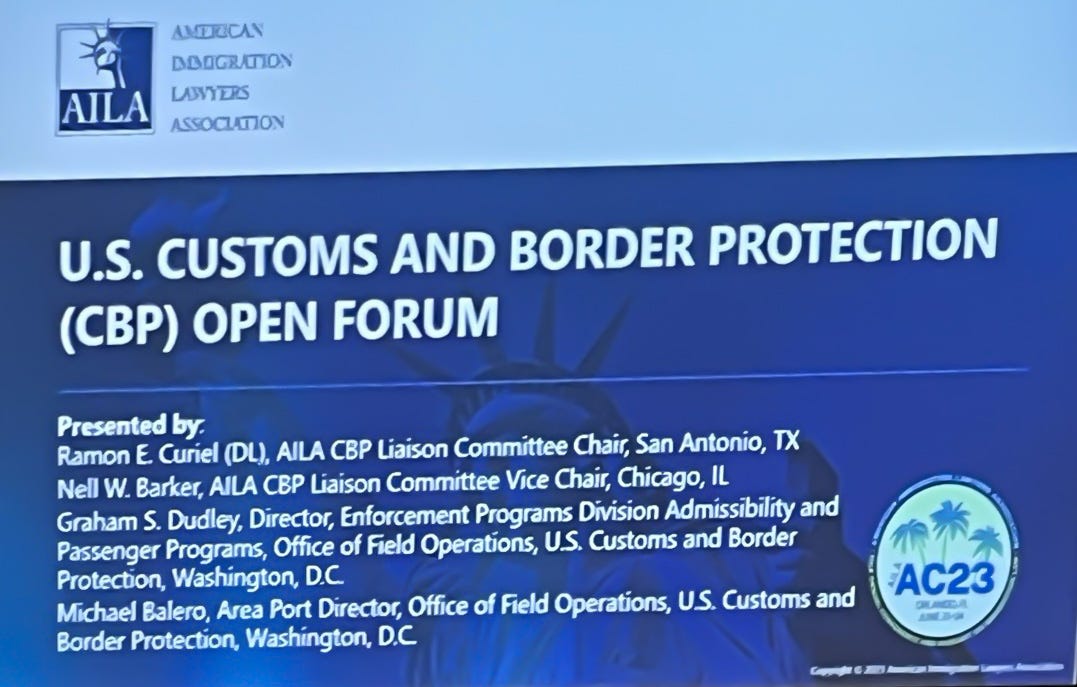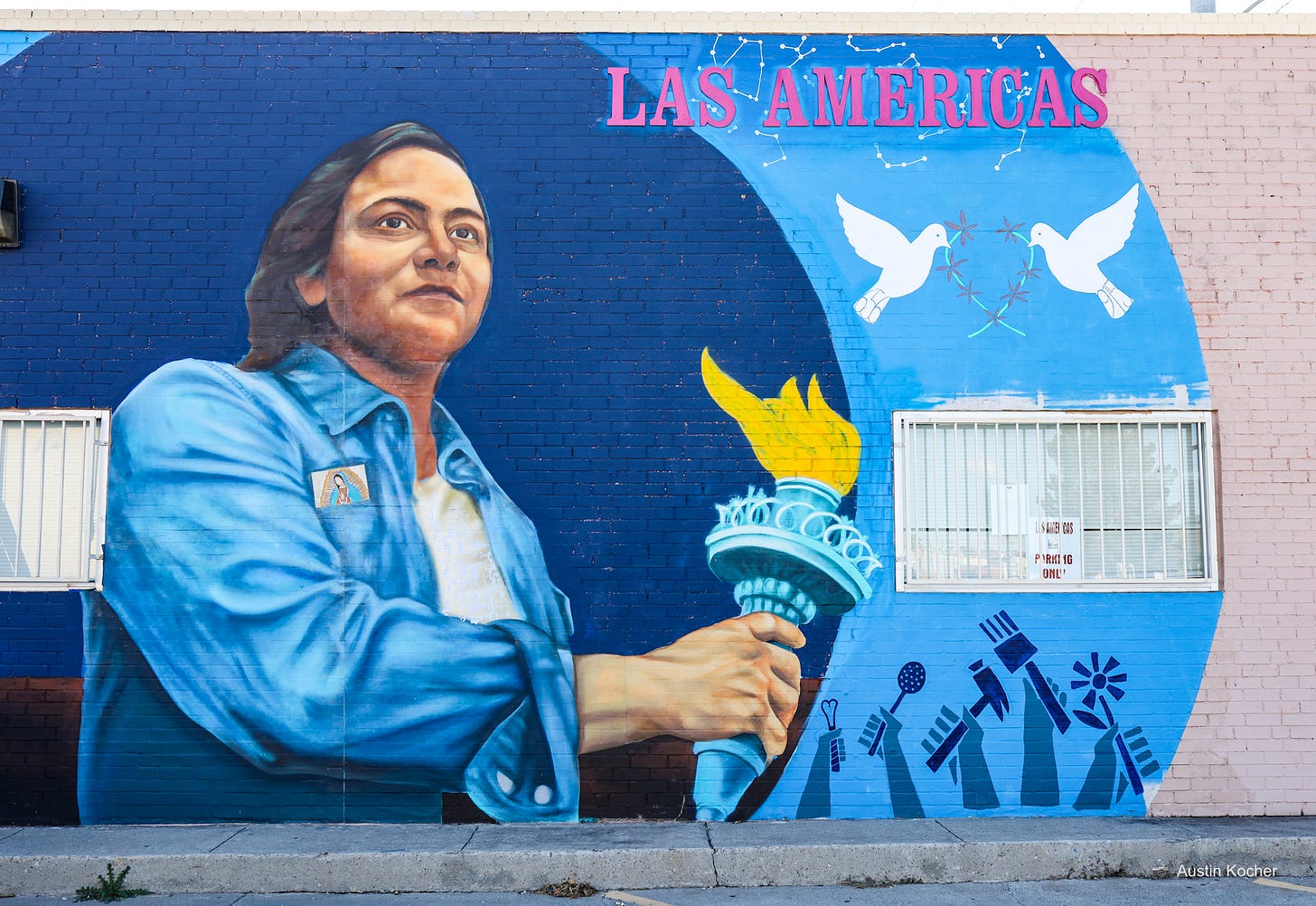CBP One and Border Logistics: Field Notes from Lily Axelrod at AILA Conference + Meet Marisa Limon Garza from Las Americas
The annual conference of the American Immigration Lawyers Association (AILA) is happening this week in Orlando, Florida, which means I’m glued to the Twitter feed of Memphis immigration attorney Lily Axelrod, who live-tweets the open forums with federal immigration agencies.
Yesterday, representatives from Customs and Border Protection (CBP) met with AILA members to share updates and answer questions. Although I do not typically attend the AILA conference because I am not an attorney, I am loosely familiar with the format because I was asked two years ago to sit in on one of these agency sessions with representatives from the Executive Office of Immigration Review (EOIR) and found it fascinating.
As usual, Lily’s thread is instructive, both because it provides a few bits of new information related to CBP One and because it provides an opportunity to highlight one essential thing that I learned in my research that I have not had the time to discuss until now: CBP One and border logistics.
Before we get started, here’s the link to the top of Lily’s thread on the CBP session and, of course, Lily’s Twitter profile. Note that Substack no longer includes previews of Twitter posts so I’m including a screenshot of Lily’s thread here.
CBP One and Border Logistics
So let’s talk about what CBP understands as CBP One’s logistical benefits.
As I have written previously, CBP One raises concerns about the consequences of technology on migrants’ access to asylum. This is an analytical perspective that views the app from the standpoint of immigration law and human rights.
But this is not the only way to understand CBP One. So let’s set aside this concern for the moment and talk about how CBP One is changing CBP’s management of the border.
Based on Lily’s thread (it’s not a transcript, obviously, but I trust her work), CBP One came up in response to several questions, including those that do not appear to have been asking about the app directly.
In a question about resource allocation after Title 42, the agency said that CBP One’s scheduling function has helped manage ports of entry by helping them know who is going to present when and at which ports of entry. (See Lily’s tweet on this here.)
The agency went on to claim that CBP One actually reduced staffing needs at the southwest border because of its logistical benefits. (See Lily’s tweet on this here.)
The reason I am emphasizing these comments is because they indicate another underlying logic of CBP One that has largely been overlooked in reporting.
That missing perspective?
Border logistics.
Logistics, as my terrific colleague Deborah Cowen has written about extensively, is an essential dimension of geopolitics. From oil pipelines to container shipping and more, logistical networks both rely upon and reproduce the modern state apparatus and should be taken seriously.
It is this logistical landscape, not merely a human rights landscape, that shapes how we should understand CBP One. And in this domain, similar to the human rights domain, the benefits of CBP One as a logistical apparatus remain a point of contention.
On the one hand, I find it not only plausible but almost self-obvious that CBP’s reliance on appointment scheduling at the southwest border has brought staffing and logistical advantages. I don’t think it takes a network engineer to recognize that knowing when people will arrive and ensuring that people arrive at a steady rate is better (for the agency) than unpredictable numbers of unscheduled arrivals. Anyone who has thrown a dinner party understands this logic.
On the other hand, one participant at the AILA panel raised a concern that I have heard elsewhere, namely that the agency’s process improvements in one area may come at the expense of processes elsewhere. For example, there are apparently unresolved issues with electronic I-94s whic are now taking longer to fix because resources have gone into CBP One. (See Lily’s tweet on this here.)
Here’s my takeaway from all this.
CBP One is not just (and maybe not even primarily) an asylum app, but rather an app developed to facilitate what I want to call border logistics. Even so, CBP One’s role in border logistics, even on its own terms, still needs evaluated empirically as part of the entire border apparatus. Moreover, CBP One is likely to be contested (as we saw above) by people who see the agency’s heavy focus on the app as detracting/distracting from other areas of importance.
This is a tension I’ll be exploring in some forthcoming work, and which I’ll continue to write about here.
As I continue this research, I would like to hear from you: What do you think are the benefits and drawbacks of incorporating technology into the US immigration system? I take comments on this work seriously and I respond to every single comments, so your feedback can absolutely help shape this research.
I encourage you to read Lily’s entire thread if you are on Twitter and follow her threads this week for more information. For an easier way to read and bookmark Lily’s thread, see the unrolled version created by Threadreader.
ICYMI: Lily’s thread comes just days after the publication of my latest article on CBP One titled Glitches in the Digitization of Asylum: How CBP One Turns Migrants’ Smartphones into Mobile Borders. I wrote up highlights in my post from Wednesday of this week, which you can visit here:
Glitches in the Digitization of Asylum
As readers of this publication know, I have developed an abiding interest in the intersection of migration and technology over the past two years, particularly the relationship between bordering, surveillance, and immigrant exclusion. This is why I’m excited to share with you my first academic article based on this research, which was just published thi…
Meet Marisa Limon Garza, E.D. of Las Americas in El Paso
FWD.us released a new video this week highlighting the work of Marisa Limon Garza, Executive Director, Las Americas Immigrant Advocacy Center. “Las Americas”, as it is known locally, is an organization based on El Paso that provides various legal and other support services to migrants. I visited Las Americas last December while conducting fieldwork along the border. In fact, one of my geography graduate school colleagues, Robert Heyman, works there now. In this video, Marisa explains what’s happening at the border right now and what Las Americas is doing to help.
Support public scholarship.
Thank you for reading. If you would like to support public scholarship and receive this newsletter in your inbox, click below to subscribe for free. And if you find this information useful, consider sharing it online or with friends and colleagues. I maintain a barebones site at austinkocher.com and I share immigration data, news, and research on Mastodon (@austinkocher), Twitter (@ackocher), and Instagram (@austinkocher). You can see my scholarly work on Google Scholar.








In an American Immigration Council webinar June 15, a panelist gave an example of another way CBP One contributes to unequal access to asylum -- in Arizona, Nogales is the only port of entry where CBP One is used, and it's 300+ miles from the nearest POE that also uses CBP One (El Paso or Calexico) and only 55 people per day are allowed across in Nogales.